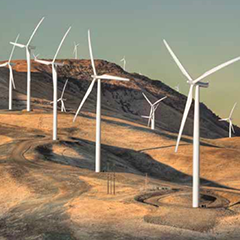This annual snapshot makes for essential reading for any domestic wind executive, charting as it does, the game-changing statics for the industry. We present a hot-off-the-press exclusive extract.
At the end of 2012, U.S. wind turbines in distributed applications reached a 10-year cumulative installed capacity of more than 812 MW from more than 69,000 units across all 50 states. In 2012 alone, nearly 3,800 wind turbines totaling 175 MW of distributed wind capacity were documented in 40 states and in the U.S. Virgin Islands, with 138 MW using utility-scale turbines (i.e., greater than 1 MW in size), 19 MW using mid-size turbines (i.e., 101 kW to 1 MW in size), and 18.4 MW using small turbines (i.e., up through 100 kW in size).
Distributed wind is defined in terms of technology application based on a wind project’s location relative to end-use and power-distribution infrastructure, rather than on technology size or project size. Distributed wind systems are connected either on the customer side of the meter (to meet the onsite load) or directly to the local grid (to support grid operations or offset large loads nearby).
Capacity-weighted average costs reported for a sample of 2012 U.S. distributed wind installations were $2,540/kW for utility-scale wind turbines, $2,810/kW for mid-sized wind turbines, and $6,960/kW for newly manufactured (domestic and imported) small wind turbines. An emerging trend observed in 2012 was an increased use of refurbished turbines. The reported capacity-weighted average cost of refurbished small wind turbines installed in 2012 was $4,080/kW.
As a result of multiple projects using utility-scale turbines, Iowa deployed the most new overall distributed wind capacity, 37 MW, in 2012. Nevada deployed the most small wind capacity in 2012, with nearly 8 MW of small wind turbines installed in distributed applications. In the case of mid-size turbines, Ohio led all states in 2012 with 4.9 MW installed in distributed applications.
As in previous years, state and federal policies and incentives continued to play a substantial role in the development of distributed wind projects. In 2012, U.S. Treasury Section 1603 payments and grants and loans from the U.S. Department of Agriculture’s Rural Energy for America Program were the main sources of federal funding for distributed wind projects. State and local funding varied across the country, from rebates to loans, tax credits, and other incentives.
Reducing utility bills and hedging against potentially rising electricity rates remain drivers of distributed wind installations. In 2012, other drivers included taking advantage of the expiring U.S. Treasury Section 1603 program and a prosperous year for farmers. While 2012 saw a large addition of distributed wind capacity, considerable barriers and challenges remain, such as a weak domestic economy, inconsistent state incentives, and very competitive solar photovoltaic and natural gas prices.
The distributed wind industry remains committed to improving the marketplace by advancing third-party certification of wind turbines and introducing alternative financing models, such as third-party power purchase agreements and lease-to-own agreements.





























